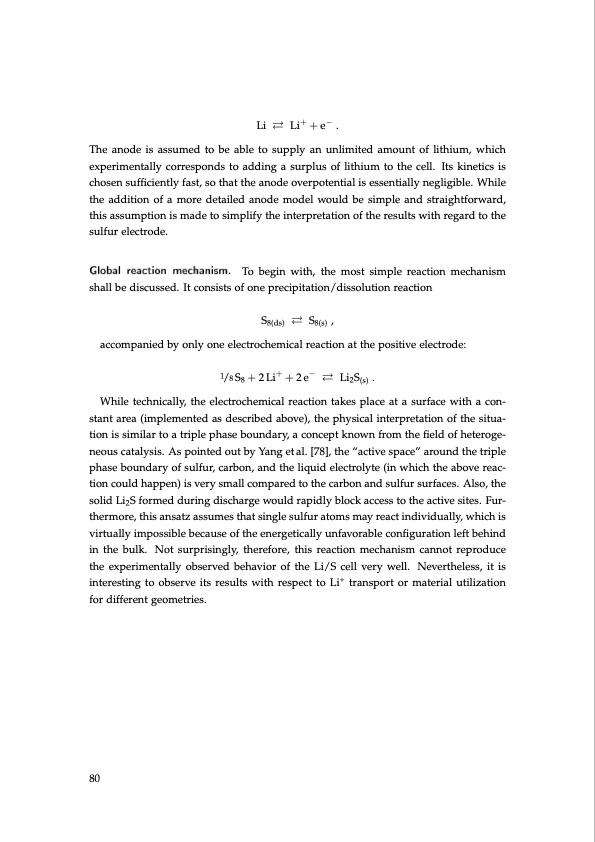
PDF Publication Title:
Text from PDF Page: 080
Li Li+ + e− . The anode is assumed to be able to supply an unlimited amount of lithium, which experimentally corresponds to adding a surplus of lithium to the cell. Its kinetics is chosen sufficiently fast, so that the anode overpotential is essentially negligible. While the addition of a more detailed anode model would be simple and straightforward, this assumption is made to simplify the interpretation of the results with regard to the sulfur electrode. Global reaction mechanism. To begin with, the most simple reaction mechanism shall be discussed. It consists of one precipitation/dissolution reaction S8(ds) S8(s) , accompanied by only one electrochemical reaction at the positive electrode: 1/8S8+2Li++2e− Li2S(s). While technically, the electrochemical reaction takes place at a surface with a con- stant area (implemented as described above), the physical interpretation of the situa- tion is similar to a triple phase boundary, a concept known from the field of heteroge- neous catalysis. As pointed out by Yang et al. [78], the “active space” around the triple phase boundary of sulfur, carbon, and the liquid electrolyte (in which the above reac- tion could happen) is very small compared to the carbon and sulfur surfaces. Also, the solid Li2S formed during discharge would rapidly block access to the active sites. Fur- thermore, this ansatz assumes that single sulfur atoms may react individually, which is virtually impossible because of the energetically unfavorable configuration left behind in the bulk. Not surprisingly, therefore, this reaction mechanism cannot reproduce the experimentally observed behavior of the Li/S cell very well. Nevertheless, it is interesting to observe its results with respect to Li+ transport or material utilization for different geometries. 80PDF Image | Lithium-Sulfur Battery: Design, Characterization, and Physically-based Modeling

PDF Search Title:
Lithium-Sulfur Battery: Design, Characterization, and Physically-based ModelingOriginal File Name Searched:
Dissertation_David_N._Fronczek_The_Lithium_Sulfur_Battery.pdfDIY PDF Search: Google It | Yahoo | Bing
Sulfur Deposition on Carbon Nanofibers using Supercritical CO2 Sulfur Deposition on Carbon Nanofibers using Supercritical CO2. Gamma sulfur also known as mother of pearl sulfur and nacreous sulfur... More Info
CO2 Organic Rankine Cycle Experimenter Platform The supercritical CO2 phase change system is both a heat pump and organic rankine cycle which can be used for those purposes and as a supercritical extractor for advanced subcritical and supercritical extraction technology. Uses include producing nanoparticles, precious metal CO2 extraction, lithium battery recycling, and other applications... More Info
| CONTACT TEL: 608-238-6001 Email: greg@infinityturbine.com | RSS | AMP |